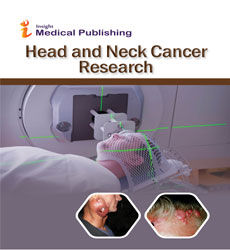Abstract
Oncological Efficacy of Ktp Laser in Early Glottic Cancer
Background: Early glottic cancer (T1, T2) is typically managed by curative-intent radiotherapy or CO2 laser resection. Disease control rates and voice outcomes are comparable. KTP laser treatment of early glottic cancer has shown promise with similar control rates in limited studies. This study presents the largest series outside its conception in Boston, USA.
Methodology: A retrospective chart review analyzed the treatment outcome of consecutive patients with early glottic cancer (T1-2 NOMO). Pre-treatment video stroboscopy and voice handicap index were compared two years following treatment. Recurrence, progression to radiation or open surgery, and mortality were recorded.
Results: For 61 patients (average age 61 years, 59 males) 34=T1a, 15=T1b, 9=T2a and 3=T2b. Three had prior irradiation and were excluded. Four patients had recurrence (6.9%): Two CIS (treated with repeat KTP laser surgery), two SCC (one recurrence progressed to open partial resection and chemo-radiotherapy with subsequent total laryngectomy for a nonfunctioning cancer-free larynx, one recurrence progressed to total laryngectomy within one year and then chemotherapy for extensive loco-regional recurrence three months later. Primary KTP laser treatment provided 100% disease-free survival at two years, larynx preservation of 96.5%, and post-surgery radiation at 2%. Radiotherapy was preserved as a future option in 98% of patients (100% in T1, 91.6% in T2). The cure rate was 96.5% (Two-year minimum follow-up).
Conclusion: This study provides further data supporting the oncological efficacy of KTP laser treatment in early glottic cancer. Recurrence and salvage total laryngectomy rates are low with the former often amenable to repeat KTP laser treatment. There is a minimal requirement for post-surgery radiation allowing its preservation as a future treatment in 98%.
Author(s): Matthew S Broadhurst
Abstract | Full-Text | PDF
Share this

Google scholar citation report
Citations : 28
Head and Neck Cancer Research received 28 citations as per google scholar report
Abstracted/Indexed in
- Google Scholar
- JournalTOCs
- China National Knowledge Infrastructure (CNKI)
- WorldCat
- Publons
- Secret Search Engine Labs
Open Access Journals
- Aquaculture & Veterinary Science
- Chemistry & Chemical Sciences
- Clinical Sciences
- Engineering
- General Science
- Genetics & Molecular Biology
- Health Care & Nursing
- Immunology & Microbiology
- Materials Science
- Mathematics & Physics
- Medical Sciences
- Neurology & Psychiatry
- Oncology & Cancer Science
- Pharmaceutical Sciences


